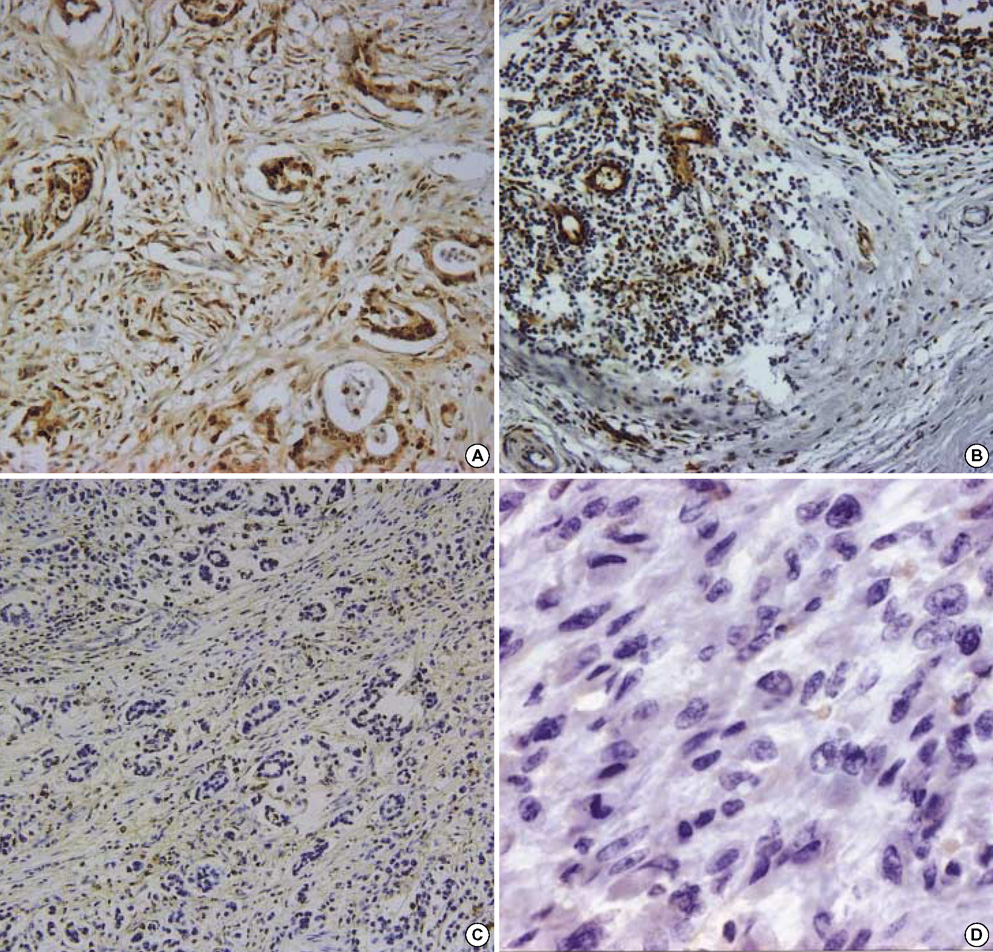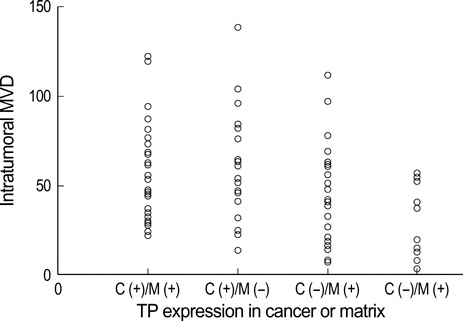J Korean Med Sci.
2007 Sep;22(Suppl):S109-S114. 10.3346/jkms.2007.22.S.S109.
The Expression of Thymidine Phosphorylase in Cancer-infiltrating Inflammatory Cells in Stomach Cancer
- Affiliations
-
- 1Division of Hematology-Oncology, Department of Internal Medicine, Gyeong-Sang Institute of Health Sciences, Gyeong-Sang National University College of Medicine, Jinju, Korea. lwshmo@hanmail.net
- 2Department of Pathology, Gyeong-Sang National University College of Medicine, Jinju, Korea.
- 3Department of Surgery, Gyeong-Sang National University College of Medicine, Jinju, Korea.
- 4Gyeongnam Regional Cancer Center, Jinju, Korea.
- KMID: 1785798
- DOI: http://doi.org/10.3346/jkms.2007.22.S.S109
Abstract
- Thymidine phosphorylase (TP) has shown to be up-regulated in several cancers and to play a role in angiogenesis and invasion. Most studies regarding TP have focused on cancer cells. Recently, evidences suggest that TP in cancer-infiltrating inflammatory cells (CIICs) also affect the cancer cell behavior. To evaluate the significance of TP expression of CIICs in gastric cancer, we assessed TP expression of cancer cells and CIICs separately using immunohistochemical assay on 116 paraffin-embedded tissue samples from stomach cancer patients and investigated their clinical significance. When subjects were divided into 4 groups according to the TP expression: cancer/matrix (+/+), C/M (+/-), C/M (-/+), and C/M (-/-), intratumoral microvessel density scores were higher in the C/M (+/-) group than in the C/M (-/-) group (p=0.02). For lymph node metastasis and survival, there were no significant differences among the 4 groups. However, there were significant differences in survival (p=0.035) and LN metastasis (p=0.023) between the two groups divided by TP expression of CIICs alone irrespective of TP expression of cancer cells. Taken together, this study suggested the TP expression in CIICs could affect lymph node metastasis and patients' survival in gastric cancer.
MeSH Terms
-
Adult
Aged
Female
Humans
Immunohistochemistry
Inflammation/*enzymology/pathology
Kaplan-Meiers Estimate
Lymphatic Metastasis
Lymphocytes, Tumor-Infiltrating/*enzymology/pathology
Male
Microcirculation/pathology
Middle Aged
Neovascularization, Pathologic
Prognosis
Stomach Neoplasms/blood supply/*enzymology/mortality/pathology
Thymidine Phosphorylase/*metabolism
Figure
Reference
-
1. Focher F, Spadari S. Thymidine phosphorylase: a two-face Janus in anticancer chemotherapy. Curr Cancer Drug Targets. 2001. 1:141–153.
Article2. Miwa M, Ura M, Nishida M, Sawada N, Ishikawa T, Mori K, Shimma N, Umeda I, Ishitsuka H. Design of a novel oral fluoropyrimidine carbamate, capecitabine, which generates 5-fluorouracil selectively in tumours by enzymes concentrated in human liver and cancer tissue. Eur J Cancer. 1998. 34:1274–1281.
Article3. Tanigawa N, Amaya H, Matsumura M, Katoh Y, Kitaoka A, Aotake T, Shimomatsuya T, Rosenwasser OA, Iki M. Tumor angiogenesis and expression of thymidine phosphorylase/platelet derived endothelial cell growth factor in human gastric carcinoma. Cancer Lett. 1996. 108:281–290.4. Sakatani T, Okamoto E, Tsujitani S, Ikeguchi M, Kaibara N, Ito H. Expressions of thymidine phosphorylase (dThdPase) and vascular endothelial growth factor on angiogenesis in intestinal-type gastric carcinoma. Oncol Rep. 2000. 7:831–836.
Article5. Osaki M, Sakatani T, Okamoto E, Goto E, Adachi H, Ito H. Thymidine phosphorylase expression results in a decrease in apoptosis and increase in intratumoral microvessel density in human gastric carcinomas. Virchows Arch. 2000. 437:31–36.
Article6. Konno S, Takebayashi Y, Aiba M, Akiyama S, Ogawa K. Clinicopathological and prognostic significance of thymidine phosphorylase and proliferating cell nuclear antigen in gastric carcinoma. Cancer Lett. 2001. 166:103–111.
Article7. Kimura H, Konishi K, Nukui T, Kaji M, Maeda K, Yabushita K, Tsuji M, Miwa A. Prognostic significance of expression of thymidine phosphorylase and vascular endothelial growth factor in human gastric carcinoma. J Surg Oncol. 2001. 76:31–36.
Article8. Kimura H, Konishi K, Kaji M, Maeda K, Yabushita K, Miwa A. Correlation between expression levels of thymidine phosphorylase (dThdPase) and clinical features in human gastric carcinoma. Hepatogastroenterology. 2002. 49:882–886.9. Shimaoka S, Matsushita S, Nitanda T, Matsuda A, Nioh T, Suenaga T, Nishimata Y, Akiba S, Akiyama S, Nishimata H. The role of thymidine phosphorylase expression in the Invasivensess of gastric carcinoma. Cancer. 2000. 88:2220–2227.10. Nagaoka H, Iino Y, Takei H, Morishita Y. Platelet-derived endothelial cell growth factor/thymidine phosphorylase expression in macrophages correlates with tumor angiogenesis and prognosis in invasive breast cancer. Int J Oncol. 1998. 13:449–454.
Article11. Koukourakis MI, Giatromanolaki A, Kakolyris S, O'Byrne KJ, Apostolikas N, Skarlatos J, Gatter KC, Harris AL. Different patterns of stromal and cancer cell thymidine phosphorylase reactivity in non-small-cell lung cancer: impact on tumour neoangiogenesis and survival. Br J Cancer. 1998. 77:1696–1703.
Article12. Takahashi Y, Bucana CD, Akagi Y, Liu W, Cleary KR, Mai M, Ellis LM. Significance of platelet-derived endothelial cell growth factor in the angiogenesis of human gastric cancer. Clin Cancer Res. 1998. 4:429–434.13. Yao Y, Kubota T, Sato K, Kitai R. Macrophage Infiltration-associated thymidine phosphorylase expression correlates with increased microvessel density and poor prognosis in astrocytic tumors. Clin Cancer Res. 2001. 7:4021–4026.14. Giatromanolaki A, Koukourakis MI, Stathopoulos GP, Kapsoritakis A, Paspatis G, Kakolyris S, Sivridis E, Georgoulias V, Harris AL, Gatter KC. Angiogenic interactions of vascular endothelial growth factor, of thymidine phosphorylase, and of p53 protein expression in locally advanced gastric cancer. Oncol Res. 2000. 12:33–41.
Article15. Takahashi Y, Cleary KR, Mai M, Kitadai Y, Bucana CD, Ellis LM. Significance of vessel count and vascular endothelial growth factor and its receptor (KDR) in intestinal-type gastric cancer. Clin Cancer Res. 1996. 2:1679–1684.16. Kono T, Nishida M, Inagaki N, Tanaka Y, Yoneda M, Kasai S. Development and characterization of 1C6-203, a new monoclonal antibody specific to human thymidine phosphorylase. J Histochem Cytochem. 2001. 49:131–138.
Article17. Japanese gastric cancer association. Japanese classification of gastric carcinoma, 2nd English Edition. Gastric Cancer. 1998. 1:10–24.18. Weidner N, Semple JP, Welch WR, Folkman J. Tumor angiogenesis and metastasis correlation in invasive breast cancer. N Engl J Med. 1991. 324:1–8.19. Shimaoka S, Matsushita S, Nitanda T, Matsuda A, Nioh T, Suenaga T, Nishimata Y, Akiba S, Akiyama S, Nishimata H. The role of thymidine phosphorylase expression in the Invasivensess of gastric carcinoma. Cancer. 2000. 88:2220–2227.20. Koizumi W, Saigenji K, Nakamaru N, Okayasu I, Kurihara M. Prediction of response to 5'-deoxy-5-fluorouridine (5'-DFUR) in patients with inoperable advanced gastric cancer by immunostaining of thymidine phosphorylase/platelet-derived endothelial cell growth factor. Oncology. 1999. 56:215–222.
- Full Text Links
- Actions
-
Cited
- CITED
-
- Close
- Share
- Similar articles
-
- Thymidine phosphrylase (TP) in cancer-infiltrating inflammatory cells in stomach cancer: the significance of TP in prognosis and tumor angiogenesis
- Expression of thymidine phosphorylase in cervical neoplasia: correlation with clinicopathological prognostic factors
- Thymidine Phosphorylase Expression in Progression of Cervical Lesions: Histological Features and Microvessel Density
- The Schedule Dependency for Induction of Thymidine Phosphorylase Activity and the Enhancement of Capecitabine Efficacy by Docetaxel on the SNU-484 Gastric Cancer Cell Line That was Injected into Xenografted Nude Mice
- Immunohistochemical Study on the Expression of Thymidine Phosphorylase and Ki-67 in the Uterine Cervical Neoplasia





